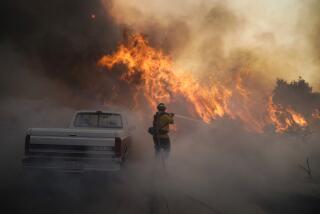Why FEMA Was Missing in Action
WASHINGTON — While the federal government has spent much of the last quarter-century trimming the safety nets it provides Americans, it has dramatically expanded its promise of protection in one area — disaster.
Since the 1970s, Washington has emerged as the insurer of last resort against floods, fires, earthquakes and — after 2001 — terrorist attacks.
But the government’s stumbling response to the storm that devastated the nation’s Gulf Coast reveals that the federal agency singularly most responsible for making good on Washington’s expanded promise has been hobbled by cutbacks and a bureaucratic downgrading.
The Federal Emergency Management Agency once speedily delivered food, water, shelter and medical care to disaster areas, and paid to quickly rebuild damaged roads and schools and get businesses and people back on their feet. Like a commercial insurance firm setting safety standards to prevent future problems, it also underwrote efforts to get cities and states to reduce risks ahead of time and plan for what they would do if calamity struck.
But in the aftermath of the Sept. 11 attacks, FEMA lost its Cabinet-level status as it was folded into the giant new Department of Homeland Security. And in recent years it has suffered budget cuts, the elimination or reduction of key programs and an exodus of experienced staffers.
The agency’s core budget, which includes disaster preparedness and mitigation, has been cut each year since it was absorbed by the Homeland Security Department in 2003. Depending on what the final numbers end up being for next fiscal year, the cuts will have been between about 2% and 18%.
The agency’s staff has been reduced by 500 positions to 4,735. Among the results, FEMA has had to cut one of its three emergency management teams, which are charged with overseeing relief efforts in a disaster. Where it once had “red,” “white” and “blue” teams, it now has only red and white.
Three out of every four dollars the agency provides in local preparedness and first-responder grants go to terrorism-related activities, even though a recent Government Accountability Office report quotes local officials as saying what they really need is money to prepare for natural disasters and accidents.
“They’ve taken emergency management away from the emergency managers,” complained Morrie Goodman, who was FEMA’s chief spokesman during the Clinton administration. “These operations are being run by people who are amateurs at what they are doing.”
Richard W. Krimm, a former senior FEMA official for several administrations, agreed. “It was a terrible mistake to take disaster response and recovery and disaster preparedness and mitigation, and put them in Homeland Security,” he said.
Homeland Security Secretary Michael Chertoff acknowledged in interviews Sunday that Washington was insufficiently prepared for the hurricane that laid waste to New Orleans and surrounding areas. But he defended its performance by arguing that the size of the storm was beyond anything his department could have anticipated and that primary responsibility for handling emergencies rested with state and local, not federal, officials.
“Before this happened, I said we need to build a preparedness capacity going forward,” Chertoff told NBC’s “Meet the Press.” He added that that was something “we have not yet succeeded in doing.”
Under the law, Chertoff said, state and local officials must direct initial emergency operations. “The federal government comes in and supports those officials,” he said.
Chertoff’s remarks, which echoed earlier statements by President Bush, prompted withering rebukes both from former senior FEMA staffers and outside experts.
“They can’t do that,” former agency chief of staff Jane Bullock said of Bush administration efforts to shift responsibility away from Washington. “The moment the president declared a federal disaster, it became a federal responsibility . The federal government took ownership over the response,” she said. Bush declared a disaster in Louisiana and Mississippi when the storm hit a week ago.
“What’s awe-inspiring here is how many federal officials didn’t issue any orders,” said Paul C. Light, an authority on government operations at New York University.
Evidence of confusion extended beyond FEMA and the Homeland Security Department on Sunday.
Health and Human Services Secretary Mike Leavitt said that conditions in New Orleans and elsewhere could quickly escalate into a major public health crisis. But asked whether his agency had dispatched teams in advance of the storm and flooding, Leavitt answered, “No.”
“None of these teams were pre-positioned,” he told CNN’s “Late Edition.” “We’re having to organize them as we go.”
Such an ad hoc approach might not have surprised Americans until recent decades because the federal government was thought to have few responsibilities for disaster relief, and what duties it did have were mostly delegated to the American Red Cross.
“A century ago, no one would have expected a massive federal response. Most people viewed natural disasters mainly as things to be endured on their own or with the help of their neighbors and communities,” said Harvard University economic historian David A. Moss, whose recent book, “When All Else Fails: Government as the Ultimate Risk Manager,” traces Washington’s expanding duties in protecting Americans from all sorts of risks.
In 1927, President Coolidge described the federal role in aiding victims of a devastating flood of the lower Mississippi River this way: “To direct the sympathy of our people to the sad plight of thousands of their fellow citizens, and to urge that generous contributions be promptly forthcoming.”
But starting with the New Deal of the 1930s and with increasing vigor in recent decades, Washington sought to prevent disasters, both natural and man-made, and to partially compensate state and local governments, companies and even individuals when calamities did strike.
The government reacted to Tropical Storm Agnes in 1972 by providing victims with grants and low-cost loans. It responded to a flood of the upper Mississippi in 1993 by approving $6.3 billion in aid. Comparing the federal government’s response in 1927 to its efforts in 1993, Moss concluded that Washington made up less than 4% of the estimated losses in the earlier flood, but more than 50% in the later one.
Within 10 days of the Sept. 11 attacks, Congress and Bush had OKd $40 billion in aid, including $15 billion in grants and loans for the staggering airline industry and $4.3 billion to compensate the families of victims.
“The federal government has dramatically increased its role in absorbing disaster losses after the fact,” Moss said. “Until recently, many may have assumed we’d made similar strides in disaster prevention.”
FEMA was created in 1979 in response to criticism about Washington’s fragmented reaction to a series of disasters, including Hurricane Camille, which devastated the Mississippi coast 10 years earlier. The agency was rocked by scandal in the 1980s and turned in such a poor performance after Hurricane Andrew struck South Florida in 1992 that President George H.W. Bush is thought to have lost votes as a result.
But according to a variety of former officials and outside experts, the agency experienced a renaissance under President Clinton’s director, James Lee Witt, speedily responding to the 1993 Mississippi flood, the 1994 Northridge earthquake and other disasters.
Witt’s biggest change was to get FEMA to focus on reducing risks ahead of disasters and funding local prevention programs.
After the 1993 flood, for instance, Witt’s agency bought homes and businesses nearest the water and moved their occupants to safer locations. The result in one Illinois town was that although more than 400 people applied for disaster aid after the flood, only 11 needed to apply two years later when the river again jumped its banks.
“He got communities to take practical steps like encouraging homeowners to bolt buildings to foundations in earthquake-prone areas and elevate living space in flood-prone ones,” said Howard Kunreuther, co-director of the Wharton Risk Center at the University of Pennsylvania.
But with the change of administration in 2001, many of Witt’s prevention programs were reduced or cut entirely. After Sept. 11, former FEMA officials and outside authorities said, Washington’s attention turned to terrorism to the exclusion of almost anything else.
*
Times staff writer Judy Pasternak contributed to this report.
More to Read
Start your day right
Sign up for Essential California for news, features and recommendations from the L.A. Times and beyond in your inbox six days a week.
You may occasionally receive promotional content from the Los Angeles Times.






